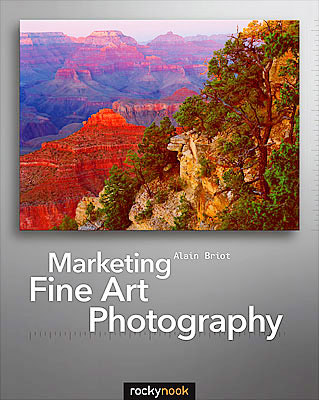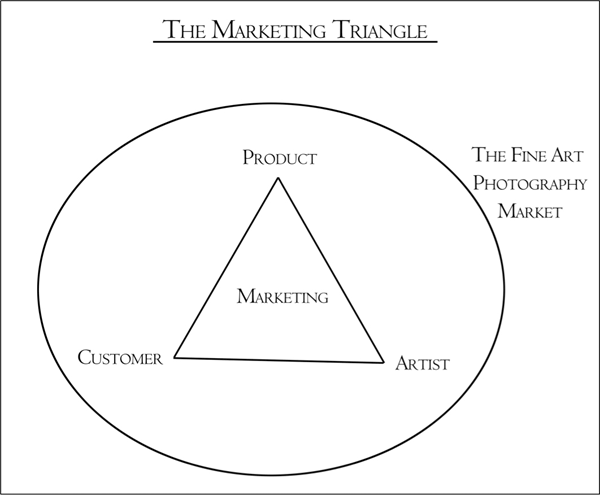|
|
The more informative your advertising, the more persuasive it will be. David Ogilvy
1 - Introduction
Fine Art Photography differs from other types of photography in that the purpose of the artist creating a fine art photograph is to express himself or herself rather than please the demands of a client. Unlike a commercial photographer who operates under contract, a fine art photographer creates images without being contracted by anyone. The artist’s only requirement is to fulfill his vision and please himself in the process. While the challenge of the commercial photographer is to fulfill the contract they signed with their client, the challenge of the fine art photographer is to convince clients to purchase artwork whose purpose is purely aesthetic and to do so after the artwork was created.
The differences between commercial and fine art photography are not always clear and as a result, a certain confusion exists in regards to the relative purpose of these two types of photography. Knowing the difference is important because it informs us how each type of photography is marketed. Commercial photography is not marketed the same way as fine art photography. While some similarities are unavoidable, the foundation of the two marketing approaches is very different.
Before getting to the core of this subject, I want to mention that I wrote a book titled Marketing Fine Art Photography. This book covers the basics when it comes to marketing Fine Art Photography. It has been in the 'top 10' books on Photography Business on Amazon.com for a long time and has earned excellent reviews since its publication. If you are new to the subject of marketing your photography, and have not read this book yet, I recommend you take a look at it. This essay does not duplicate the contents of my book. Everything here is new and different, following my publishing practice which is to avoid redundancy as much as possible.
 Marketing Fine Art Photography Printed Book eBook |
2 - What Will Make You Successful
Being successful in selling fine art photography is not related to your level of motivation or to the quality of your artwork. Rather, it is related, and in fact absolutely dependent, on knowing how fine art is marketed. In other words the theories on which this marketing is based, together with the techniques used to implement it, are the keys to success.
When I started selling my work, I was just as motivated as I am today. In a way, I was probably more motivated. I was hungry. I wanted to succeed. I wanted this to work. However, I must say that when I started I was far from being as successful as I could have been. Why? Because I knew nothing about marketing. To me, marketing was putting a price tag on a work of art and, occasionally, telling people that it was for sale. Most of the time it was simply waiting for someone to see the price tag and buy the work without interacting with me. I had no knowledge of marketing theory and, of course, I had no knowledge of the marketing techniques I could use to multiply my sales. I was totally dependent on my work selling itself, and dependent on stores and galleries, to provide what I now call ‘mercy marketing’ for my work.
3 - Why I do this...
I decided to start my own business to gain financial independence while doing what I love. Some may say that I wanted it all. I won’t object to that even though at the time I did not see things that way. When I started, I simply wanted to do what I liked while making the same amount of money I made as a graduate teaching assistant. I had no dreams of being wealthy. Doing what I loved was better than doing work that I no longer enjoyed. If I could make the same amount of money doing what I liked instead of being an underpaid and overworked grad student then the benefit was unquestionable.
At the time I made roughly $600 a month as a graduate teaching assistant. I divided $600 by 30, the number of days in a month, and this came to $20 a day. I told myself that if I could make $20 a day selling my photographs I would be in the same financial situation except I would be doing what I liked instead of what I was forced to do. Certainly, I would incur production and business expenses, but when I started my business those were minimal. I was printing everything myself to minimize printing costs, I was not travelling to avoid travel costs and I was not buying advertising to reduce business expenses to a minimum. All in all my main expenses were paper and ink.
At the time I was selling my work through local galleries and nearby National Park giftstores. While the income was low, I soon found out that making $20 in sales per day was not difficult. It amounted to $150 per week, which was the price I asked at the time for a 16” x 20” photograph. Therefore, if I sold one 16” x 20” photograph I had reached my financial goal for the week. I also sold packs of notecards for $5 per pack. Selling 4 packs a day, or 30 packs per week, also allowed me to reach my goal. Often I sold a combination of both cards and photographs and I was soon able to reach my income goal consistently. I could then do one of two things: try to sell more pieces or create new products. I found out that doing both was the best approach because both were necessary to grow my business. I needed to sell more to increase my income, and I needed to create new products to diversify my offerings and reach a wider audience.
As I built my business, doing what I loved was soon merged with creating financial independence for myself. I found that these two goals worked hand in hand. As I created new products and reached a wider audience, I realized that I was taking control of my income. How much I made was no longer dependent on ‘the boss’ or on ‘climbing the social ladder’ or on getting promoted. Instead, how much I made was related to the products I offered to my audience. If I wanted more money, all I had to do was create a new product, enlarge my buying audience, raise my prices or do a combination of these three elements. The amount of extra money I made was dependent on the success of this new product, the level of my pricing and the size of my target audience. The more popular the product, the higher the price and the larger the target audience, the more money I made. The great thing is I was doing all this while continuing to do what I loved, which was creating fine art photographs.
There are misconceptions about what is financial independence. Before starting my own business I believed that financial independence was having enough money to not have to work. Certainly, it can be that. If someone has enough money and never has to work another day in their life, they certainly are financially independent. They do not depend on anyone to provide them with income and they can do whatever they please with the money they have. Unfortunately, to be part of this group you have to either be born wealthy or retire with sufficient residual income, neither of which was my lot. I had no money whatsoever and I was far from being able to retire. In fact, the way things looked at the time I could not consider retiring ever!
However, I soon realized that there was another form of financial independence, one that had eluded me because so far I had been an employee. As an employee my income was my salary. To make more money I had to either climb the social ladder, a slow and often frustrating process, or get a new and better paying job. In other words, someone else was in control of my income. I was not in charge of how much I made. If I needed more money next week, there was little I could do except cut down on my expenses or borrow money.
As a self employed person however my income was dependent on my actions. If I needed more money I could create a new product, offer it to my audience and increase my income that way. I did not need to be retired or have enough money to live on to be financially independent. All I had to do was take advantage of a situation that favored free enterprise as form of income, rather than depend on climbing the social ladder to increase my paycheck.
I soon found out that one thing controlled my success when offering a new product to my audience. This one thing was marketing. Creating a new product was important. Offering it to my target audience was also important. But marketing this new product to convince my audience to buy it was even more important. In other words marketing was the critical factor that determined how well my new product was going to sell and, by extension, how much money I was going to make.
4 - Why do you want to do this?
I assume that you are reading this essay because you are either selling your work or considering doing so. For these reasons, and to make things 100% clear, I need to mention that selling fine art is difficult. There are much easier ways of making a living! Therefore knowing precisely the reasons why you want to do this is important. Knowing these reasons will sustain your efforts and will provide the necessary motivation to overcome the difficulties you will face as you move forward selling your photography. Knowing the reasons why you want to do this will also make the difference between being interested in doing this and being committed to doing this.
If you have not done so yet, the simplest way of answering the question "why do you want to do this?" is to list as many reasons as you can think of about why you want to make a living selling your photography. In doing so be as detailed as possible and explain the logic behind each reason. Why is each reason important? Why does it matter to you? What led you to think this way? Knowing precisely why you want to do this will give you the strength and the motivation to overcome the difficulties that lie ahead.
5 - Using Time Wisely
Let's return to the matter at hand. If something defines your income and can potentially make you financially independent, you have to give it your attention. I therefore involved myself in an in-depth study of marketing. It soon became clear to me that creating new products and offering them to my audience was not enough to generate financial independence. Myself, as well as all the artists I knew, were constantly creating new work and offering it to our audience and yet few sales were made. In fact, sales were not made for every new piece, far from that. While I was making enough sales to meet my daily income goal of $20, doing so was not going to make me financially independent. It matched grad student income, which was my original goal, but it did not put me in a financially enviable position in the least.
The main problem was the use of my time. I spent a lot of time perfecting a work of art before offering it to my audience. If it did not sell, or if it did not sell in large enough quantity, I spent even more time perfecting my work and correcting things that only I could see. I did that because I believed that my work did not sell because it was not good enough. The results were disappointing. Spending more time perfecting my work and making it 'better' did not result in better sales. While it did result in artwork that I was proud of, I have to be humble and say that in regards to sales it made no difference whatsoever.
Clearly, something was amiss. Offering new and better products to customers was not enough to generate sales. Something else was necessary. This something was marketing. The problem was that I did not understand marketing. My studies were in the humanities. I studied art, writing, philosophy and rhetoric. While I had a Bachelor and Master degrees and was ABD, having worked my way to PhD dissertation level, I had never taken a single business class, let alone work on an MBA. Marketing was something new and foreign to me.
However, disappointment has a positive side: it gives you the incentive to make things better. Disappointed by my lack of sales I decided to study marketing carefully. I looked long and hard for examples of fine art photographers marketing their work successfully, but did not find any that I could relate to. Most were not doing any marketing and those who did were so far beyond me that their marketing was too costly and too complex for me to implement. I therefore sought to simplify things and design a simple marketing system that I could use at low or no cost because I had very little money.
 The marketing triangle as applied to fine art photography |
It dawned on me that there was three main elements in the buying/selling relationship: me (the artist), my product (the photograph) and the client (the source of income). The question was finding out how do these three elements relate to one another. At first, I thought that photography was what brought these elements together and this is why I put my efforts into making my work better. However, this did not work because I was wrong. The element that brought all three parties together was not photography, it was marketing. Photography was the larger context into which these four elements - artist, client, artwork and marketing - operated. The puzzle was complete. The answer was mine. To improve sales I needed to improve my marketing, not my photography! While having great photography was important, improving the quality of my work would not generate more sales. To increase my sales I needed to increase the quality of my marketing, not the quality of my work.
Next month: Part 2
This is the end of part one, part two will be published next month and will feature the following 6 sections:
- Don’t get it twisted
- How Digital Photography changed the game
- The advantages and disadvantages photographers have to contend with
- How artists are perceived
- The positive characteristics of artists
- Approaching business successfully as an artist
Stay tuned for next month’s installment!
The Advanced Marketing Fine Art Photography Mastery Workshop on DVD
If you want to learn how to sell your work successfully, take a look at my upcoming tutorial: the Advanced Fine Art Photography Marketing Mastery Workshop on DVD. I have a ‘spoiler’ listing some of the major contents at this link.
I have also opened a pre-registration list. Joining this list is simple: just email me at alain@beautiful-landscape.com and you will be first notified when this new tutorial is published. You will also benefit from the lowest price and from special offer gifts and freebies.
Alain Briot - NPN 2054
|
 Alain Briot creates fine art photographs, teaches workshops and offers DVD tutorials on composition, conversion, optimization, printing and marketing photographs. Alain is also the author of Mastering Landscape Photography. Mastering Photographic Composition, Creativity and Personal Style and Marketing Fine Art Photography. All 3 books are available from Amazon and other bookstores as well from Alain’s website.
Alain Briot creates fine art photographs, teaches workshops and offers DVD tutorials on composition, conversion, optimization, printing and marketing photographs. Alain is also the author of Mastering Landscape Photography. Mastering Photographic Composition, Creativity and Personal Style and Marketing Fine Art Photography. All 3 books are available from Amazon and other bookstores as well from Alain’s website.
You can find more information about Alain's work, writings and tutorials as well as subscribe to Alain’s Free Monthly Newsletter on his website at http://www.beautiful-landscape.com To subscribe simply go to http://www.beautiful-landscape.com and click on the Subscribe link at the top of the page. You will have access to over 40 free essays by Alain, in PDF format, immediately after subscribing.
Alain welcomes your comments on this essay as well as on his other essays. You can reach Alain directly by emailing him at alain@beautiful-landscape.com.